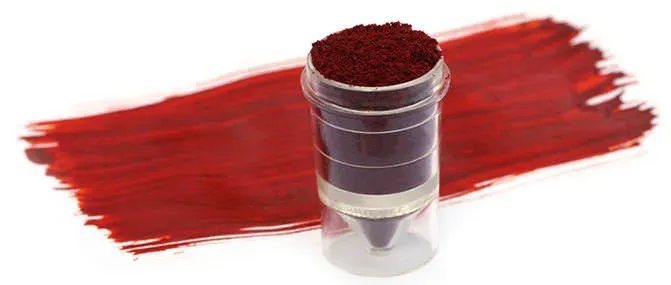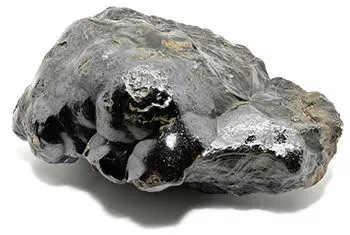 Hematite is a red oxide of iron, like iron rust. The name hematite comes from the Greek word haima, or ema, meaning 'blood,' as it shows a blood red color when cut into thin slices. As such, hematite is also called 'bloodstone.' Sometimes, when the stone has a layered appearance, like the petals of a flower, it's called 'iron rose.' Hematite has a long history as a material with many different uses. Hematite crystals that are shiny have traditionally been used in mirrors, and are sometimes called specular hematite. From 2500 BC to 500 BC, hematite was used to make cylindrical seals. Hematite has also been ground and powdered, and used by artists as a pigment, or for polishing. In fact, powdered hematite was used by prehistoric man for cave paintings, by the Egyptians to decorate the tombs of pharaohs, and by Native Americans as a war paint. Today, it is still used as pigment, as well as a metal polishing powder called 'jeweler's rouge.'
Hematite is a red oxide of iron, like iron rust. The name hematite comes from the Greek word haima, or ema, meaning 'blood,' as it shows a blood red color when cut into thin slices. As such, hematite is also called 'bloodstone.' Sometimes, when the stone has a layered appearance, like the petals of a flower, it's called 'iron rose.' Hematite has a long history as a material with many different uses. Hematite crystals that are shiny have traditionally been used in mirrors, and are sometimes called specular hematite. From 2500 BC to 500 BC, hematite was used to make cylindrical seals. Hematite has also been ground and powdered, and used by artists as a pigment, or for polishing. In fact, powdered hematite was used by prehistoric man for cave paintings, by the Egyptians to decorate the tombs of pharaohs, and by Native Americans as a war paint. Today, it is still used as pigment, as well as a metal polishing powder called 'jeweler's rouge.'
 Hematite is a dark, blackish gray opaque stone with a metallic luster. It has an extremely high brilliance and shine and takes a metallic polish that can look silver, pure black, or gunmetal blue. Hematite rates a 6.5 on the hardness scale. Thick crystals are suitable for cutting into gemstones. It is popular for jewelry, however because of its high density, pieces can be heavy. Hematite is used for ornamental pieces, as well as fashioning into necklace beads, pendants and rings. It can also be engraved and has always been popular for carving cameo pieces known as intaglio. Hematite's value is low, but beautifully engraved pieces are highly valued.
Hematite is a dark, blackish gray opaque stone with a metallic luster. It has an extremely high brilliance and shine and takes a metallic polish that can look silver, pure black, or gunmetal blue. Hematite rates a 6.5 on the hardness scale. Thick crystals are suitable for cutting into gemstones. It is popular for jewelry, however because of its high density, pieces can be heavy. Hematite is used for ornamental pieces, as well as fashioning into necklace beads, pendants and rings. It can also be engraved and has always been popular for carving cameo pieces known as intaglio. Hematite's value is low, but beautifully engraved pieces are highly valued.
 Hematite is found in iron-mining areas. It is deposited in hydrothermal veins associated with magmatic rocks however the largest deposits are of sedimentary origin. Hematite usually occurs as massive opaque material. It can also occur as short rhombohedral crystals, which are black or dark iron gray with iridescent surfaces. Crystals can also be earthy or red in color. The largest deposits of hematite are found in Quebec, Canada, around Lake Superior. Iron roses are found in Switzerland and Brazil. High quality hematite, which is suitable for cutting is found around England, Germany and Elba, Italy. Hematite is also found in various locations around Brazil, Venezuela, England, Germany, Spain, Venezuela, and the United States.
Hematite is found in iron-mining areas. It is deposited in hydrothermal veins associated with magmatic rocks however the largest deposits are of sedimentary origin. Hematite usually occurs as massive opaque material. It can also occur as short rhombohedral crystals, which are black or dark iron gray with iridescent surfaces. Crystals can also be earthy or red in color. The largest deposits of hematite are found in Quebec, Canada, around Lake Superior. Iron roses are found in Switzerland and Brazil. High quality hematite, which is suitable for cutting is found around England, Germany and Elba, Italy. Hematite is also found in various locations around Brazil, Venezuela, England, Germany, Spain, Venezuela, and the United States.
 Because of the red color inside hematite, the stone has been associated with blood for thousands of years. In the past, it was worn as protection against bleeding. It was believed to have the power to stop bleeding as well as prevent excessive bleeding in childbirth. Today, hematite is still worn to keep the blood healthy and to help cure blood-related diseases. Hematite also has other attributes to speak of. It is a powerful stone which is believed to aid in overall healing, courage, legal matters, alertness, vivacity, wealth, strength, power, business and agriculture. It calms fears, eliminates anger and fosters peace. Hematite has been used in magic for over 3000 years now. In ancient Babylon, it was carried by warriors for strength to overcome enemies, and was believed to help cause stone walls to fall. In the middle ages, hematite acted as a farmer's talisman and was worn in the belief that the stone strengthened their crops. In the 13th Century, hematite was engraved with a figure of a bat and then worn by magicians who believed it strengthened their spells.
Because of the red color inside hematite, the stone has been associated with blood for thousands of years. In the past, it was worn as protection against bleeding. It was believed to have the power to stop bleeding as well as prevent excessive bleeding in childbirth. Today, hematite is still worn to keep the blood healthy and to help cure blood-related diseases. Hematite also has other attributes to speak of. It is a powerful stone which is believed to aid in overall healing, courage, legal matters, alertness, vivacity, wealth, strength, power, business and agriculture. It calms fears, eliminates anger and fosters peace. Hematite has been used in magic for over 3000 years now. In ancient Babylon, it was carried by warriors for strength to overcome enemies, and was believed to help cause stone walls to fall. In the middle ages, hematite acted as a farmer's talisman and was worn in the belief that the stone strengthened their crops. In the 13th Century, hematite was engraved with a figure of a bat and then worn by magicians who believed it strengthened their spells.